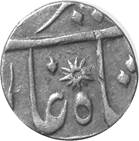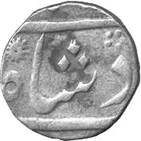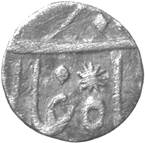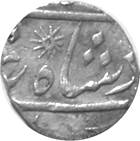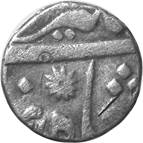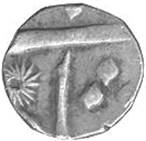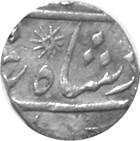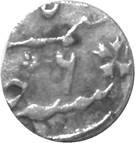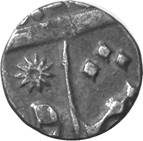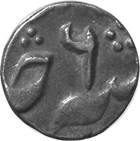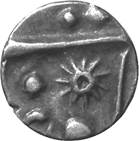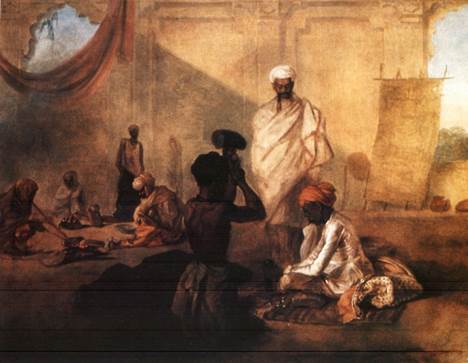|
Summary |
In
1756, the Nawāb of Bengal attacked and captured Calcutta whereupon the British
sent an army and fleet to recapture the town, which they did in January 1757.
Following this they obliged the Nawāb to grant them the right to
establish a mint and they began to strike coins, at first showing the mint
name Alīnagar Kalkutta, Alīnagar being the name given to the town
by the Nawāb. However, later in the year, following the battle of
Plassey, the new Nawāb allowed the EIC to strike coins with the mint
name Kalkutta. Coins with this mint name were struck in years 4, 5 and 6 of
Ālamgīr II, but the shroffs imposed a heavy batta on these and it proved impossible to get them into
circulation. At the very end of 1760, the EIC requested, and obtained,
permission to strike coins with the mint name Murshīdābād.
These new coins were first issued in the name of Ālamgīr II, AH
1174, RY 6. The Calcutta authorities also decided to begin minting silver
coins with the mint name Arkot, in Calcutta and applied to Madras for the
dies. The
only copper coins issued, were tickets struck for the use of the workers
employed in repairing and expanding the town’s fortifications. During
these early years the method of operation of the mint was established,
although it was not until later that a truly professional approach was
adopted. |
|
|
Detailed Discussion |
The
rich trade of For
reasons that are not relevant here, in 1756, Siraj al-Dowla,
the Nawāb of Bengal, attacked and captured Calcutta. He renamed the city
Alīnagar and issued coins bearing this mint name, presumably from a mint
established in the city, although they may have been struck elsewhere [1].
‘Alīnagar’
Rupee, RY 3 of Ālamgīr These
coins are extremely rare but the example shown here clearly shows the mint
name, Alinagar, in the top line on the reverse and
regnal year 3 of Ālamgīr II. A
British army led by Admiral Watson, with Colonel Robert Clive in charge of
land forces, was despatched to retake the city, and this they did on On
Agreed that we do
establish a mint and coin sicca rupees with the name of the Moghul on one
side and the Company on the other, to be of the same weight as Muxadavad rupees and to pass in the town for 2 p cent
more This
was put to the Nawab, inter alia,
through an intermediary, Coja Wajid, on 21st
January [3]: 4. That he suffer the Company
to erect a mint in Calcutta, endowed with the same priviledges
with the mint at Muxadavad, and that if the rupees
of Calcutta be of equal weight and fineness with those of Muxadavad
they may pass current without any deduction of batta but
the reply was not encouraging [4]: 4. As regards the fourth
article he says that, seeing that the English nation has never had this priviledge in Bengal, it is not right to demand it, and
further the Nawab is not able to grant a right which depends upon the Mogul and
which might damage the currency of that Prince. As well as Coja Wajid, the
British appear to have been negotiating with the Nawāb through the
French because in a letter from the Council at Bengal to the Court of
Directors in London later in January they stated [5]: The demands we verbally
made the French deputies were in substance: to have the restitution of our
losses and satisfaction for the damages and charges sustained in consequence
of the suba’s violences, to have permission to
erect such fortifications as we might think proper in whatever part of the
country we chuse to settle a factory, and to be
allowed a mint in Calcutta. By the 1st February the Bengal Council was
able to report to I have little to observe
on the terms obtained from the Nabob except that they are both honorable and advantageous for the Company. The grants of
a mint and the villages hereto detained from us are very considerable and the
abolishing of the duties lately exacted by the chowkies
as well as confirming the free transportation of goods without customs of any
kind, and the rest of the priviledges of the royal phirmaund, are no small points gained. On 6th February, Clive received confirmation
that the Nawab would grant the right of minting [7]: …The Nawab agrees to
give you back Calcutta with all the priviledges of
your phirmaund and whatever goods you lost at Cossimbuzar or elsewhere, and will grant you permission
to coin siccas in your mint at Calcutta or Allenagur,… and Clive conveyed this to the Select Committee at Fort
St George, … The Nawab has decamped
with his whole army, has wrote me a letter that he will comply with all our
demands except a sum of money for the inhabitants, viz. that he will put us
in possession of everything granted by the royal phirmaund,
liberty to fortify Fort William as we please, and liberty of a mint The next day Clive submitted his draft treaty and the
Nawab agreed to the proposal for minting coins [9]: Article 5. That we shall
have liberty to coin siccas both gold and silver, of equal weight and
fineness as those of Muxadabad, which shall pass
current in the province, and that there be no demand made for a deduction of
batta The
Nawāb endorsed this article I consent to the English
Company’s coining their own bullion into siccas. English coin shall be
stamped in the name of Allenagar An important point to note from this extract is that the
Nawab consented to the English striking coins, but with the mint name Alinagar. The final treaty was laid before Council on the 14th
February [10]: That siccas shall be
coined at Allenagar, Calcutta in the same manner as
that at Muxadabad, and that if the money struck at
Calcutta be of equal weight and fineness with that of Muxadabad,
there shall be no demand made for a deduction of batta. But this was still not sufficient for Clive, and Mr Watts
in Murshidabad was asked to clarify the matter further [11]: …Secondly. You must get
the article of the mint explained in fuller terms and extend the liberty of
coining to all bullion and gold imported into This extract implies that the minting rights were somewhat
limited, perhaps to bullion imported by the Company (and not, therefore, by
private individuals) and that the authorities at By 23rd February the Calcutta Council felt
that they should ask for an Assay Master to be sent out from The establishment of a
mint being consented to by the Nabob, we have to request your Honors will send us out an Essay Master with other
persons and materials for the better managing of that branch of business. Mr Watts, meanwhile, had been negotiating with the
Nawāb and was able to report back on the 10th March [13]: The Nawab says you may
coin siccas in Clive was still not happy and on 10th April he
wrote directly to the Nawāb [14]: It is a long time since
Your Excellency promised to fulfill everything in
15 days… I therefore take the liberty of putting down in writing what parts of
the treaty so solemnly sworn to I desire to be complied with… …3rd Parwannahs for the currency of siccas coined at On the 17th April Mr On the 24th
we received a letter from W Watts Esq dated the 18th
instant…That he had the day before [17th April] received a perwannah for coining of siccas in Calcutta, but as it
only mentions Allenagore he returned it, and hopes
to get it altered - that he is applying for a general perwannah
for the currency of our trade in the three provinces… And on 26th April the Nawāb told Clive
that he had acceded to Mr Watts demands [16]: … The several perwannahs for the currency of the Company’s business,
which are wrote agreeable to Mr Watts’s desire, together with that for
erecting a mint in Calcutta Alianagar have been put
into his hands, of which you have no doubt been informed by his letter. It is interesting that the Nawab now refers to Calcutta Alinagar and not just Alinagar.
Perhaps this was the compromise that Perwannah
of the Nabob Serajah Dowlah
to the Company for erecting a mint in From the date of the
first of the moon shaboon [ At last, they had the authority to strike their own coins
and now all they needed were people with the necessary skills to undertake
the work, and the rules and regulations to make it happen. By June, skilled
workmen had arrived from Murshīdābād and a committee was
established to look into the operating procedures [18]: The coiners and others
for carrying on the mint business being arrived from Muxadavad
the Board took into consideration the establishing of that priviledge upon a proper and beneficial foundation, but
as it is utterly impossible for them to judge how it ought to be conducted
for the advantage of our Honble Masters till the method of coining, assaying
etc is ascertained and known, the Board are of opinion that a committee
should be appointed to inspect into the fineness of silver proper for siccas,
how much a hundred ounces of the different kinds of bullion produce and what
the charge of coining will be. This, once known, we can with greater
propriety establish the mint under proper regulations. Agreed the President, Mr
Frankland and Mr Boddam be appointed to inspect
into the forementioned particulars and report them to the Board as soon as
possible By early July,
4000 (not 40,000 as stated by Pridmore several times in his work [19])
rupees had been produced [20]: The Committee appointed
for coining of siccas inform the Board a sum of 4000 R has been coined from
new Mexico Dollars and that as soon as they have coined two or three other
kinds of bullion they will deliver in the Acc’t The coins struck at this time must have been the very
rare rupees with the mint name Alīnagar Kalkutta (Cat No.xxx). A gold mohur has also been reported although the
records contain no reference to gold being struck at this time [21]. Coins with the Mint Name Kalkutta On The new Nawab was required to confirm the coining rights
of the Company again, and this he duly did on the 15th July [23]: … A mint is established
in and on 28th July he signed a Perwannah confirming the Company’s right to strike coin,
this time with the mint name Perwannah
from the Nawab Mir Jafar Ali Khan To the High and Mighty,
the bold and valient Commanders, the greatest of
merchants, the English Company in whom may the King’s favour rest forever. A
mint has been established at Calcutta; continue coining gold and silver into
siccas and mohurs, of the same weight and standard with those of Moorshedabad; the impression to be Calcutta; they shall
pass current in the province of Bengal, Behar, and Orissa, and be received
into the Codganna; there shall be no obstruction or
difficulty for Cussore…11th Zeerlaida [Zilkada] 4th
of the King’s reign [= 28th July 1757] (for a slightly different translation see reference below
[25]) The Company’s servants at Murshidabad had been discussing
the minting rights with the Nawab and his advisors, Jugganat
Seth and Dulab Ram, and their attention was drawn
to the fact that although the minting rights would allow the Company to mint
bullion brought to Calcutta by any means, the Nawab and his advisors would
not be pleased if all of the bullion imported by native Indians was dealt
with in this way so that none of it reached the mint at Murshidabad. If that
happened, then the mint at Murshidabad would have no work and the Nawab might
be obliged to withdraw the rights of coinage that he had granted to the
Company [26]. By the 8th August the mint had begun production
and fifty new coins were shown to the Calcutta Council [27]: The Committee appointed
for essaying the coinage of the different sortments
of bullion lay before the Board 50 rupees coined from Dollar silver agreeable
to the Perwannah received from Jaffir
Ally Cawn Ordered them to be
transferred to Muxadavad for a trial, and agreed
our mint be established on the same footing as that at Madrass And on the 20th August, In the packett to the Honorable the Court of Directors translate
of the general sunnud and the perwannah
for the mint are forwarded. You will observe by the last, the impression is
to be
Half
Rupee with Mint Name Kalkutta In September 1757, Messrs Frankland and Boddam were appointed joint Mint Master [29] and
the mint had swung into full operation, sending 3050 Rs to Cozimbazaar for the approval of the Nawāb and five
to London [30].
At the same time the mint was supplied with 35,000 old (Sonaut)
rupees and 805 Persian rupees for re-coining, and in October a further 50,000
old rupees were sent to the mint [31]. Also in October a significant amount of gold that had been
received from the Nawāb was sent to the mint where it was to be coined
into Fooley
(i.e. star or flower) mohurs [32]. Problems
with the Kalkutta Rupees By January 1758 the mint was working flat out, sending
80,000 Rs to Cossimbazaar to be used as a trial in
purchasing the investment for that year, but some difficulty had been
encountered in getting the Kalkutta coins into circulation [33]: We have been constantly
employed in coining both for the Company and some private persons, but as yet
there is some difficulty in passing our siccas, of which we have complained
to the durbar, and have the satisfaction to learn from Mr Scrafton
that the currency of them has been ordered by beat of the dandurra
through the streets of Muxadavad and a mutchulka given by the principal shroff that they shall
be received the same as Muxadavad siccas. We
therefore flatter ourselves that our money will very shortly be as current as
that coined in the metropolis of the subaship, when
we have hopes the Company will reap very considerable advantages from their
mint, as will likewise the private inhabitants of this place. In order to
make a tryal of the force of the late orders and
proclamation we have sent eighty thousand Calcutta siccas to Cossimbuzar for the ensuing year’s investment and shall
advise Your honors if they are received without
difficulty or if any objections are made to them… By February 1758, the problem of getting the coins into
circulation was getting worse and even British residents were refusing to
receive the coins in payment [34]: …Mr Charles Douglas…Upon
his application of the discharge of those notes we ordered the Committee of
the Treasury to pay him the amount of the principal and interest of the bonds
in his possession – being in all current rupees 119643 – which they offered
him in Calcutta siccas, but he peremptorily refused taking the amount of his
bonds in that coin, and on 12th January wrote a letter to the
Board upon that subject protesting against the Company and their
representatives for all loss of batta, interest and risque
if he was not paid in some other species of rupees. Nevertheless, the mint had produced quite a large number
of coins with the mint accounts showing the following outputs [35]: December 220,275 January 101,337 February 243,890 These figures show the value of the output of the mint not the actually number of coins
produced, some would have been rupees and some mohurs plus silver fractions
and copper. In the meantime the problems of getting the coins into
circulation were continuing. The gold mohurs that had been struck from the
Nawāb’s gold were stuck in the mint and a decision was taken to send 100
to the Ballasore factory where it was believed they
may be sold for a good price [36]. This problem seems to have caused the mint to be little
used during 1759 because at the end of that year Our Mint is at present
of very little use to us as there has been no bullion sent out of Europe this
season or two past, and we are apprehensive that it will never be attended
with all the advantages we might have expected from it, as the coining of
siccas in Calcutta interfere so much with the interests of the Seats that
they will not fail of throwing every obstacle in our way to depreciate the
value of our money in the country, notwithstanding its weight and standard is
in every respect as good as the siccas of Muxadavad,
so that a loss of batta will always arise on our money, let our influence at
the Durbar be ever so great. The ‘Seats’
referred to in this extract, were members of the great Seth banking family
who controlled the mint at Murshīdābād, amongst other things. The lack of use of the mint seems to have continued in
1760, although rupees with the mint name Kalkutta continued to be struck and
they exist with regnal years five and six of Ālamgīr. This is
confirmed by an entry in the records of June 1760 [38]: Notice to be given that
after the 23rd inst. Five sun siccas will be rec’d into the
Company’s treasury at 13 p cent batta only and that six sun siccas will be
struck & pass current from that day A further entry from a meeting held in October instructed
Mr Frankland (by then apparently the sole Mint Master) to produce copper
tickets for the use of the labourers rebuilding the fortifications of the
city [39]: The Committee of works
represent to the Board that it will be extremely troublesome and inconvenient
to pay the cowleys, labourers and bricklayers, to
be employed on the fortifications, in cowries. They recommend therefore that copper , brass or tutenague
tickets may be stampt of different values for the
payment of those people, which shall be taken back at the value stamp’d on the respective tickets. Ordered: Mr Frankland to
stamp a number of such tickets. Pridmore has identified two denominations of these copper
tickets/coins. A one anna and a six pice. A smaller, two pice, denomination
has been identified by Coins with the Mint
Name Murshīdābād Struck in the Calcutta Mint Pridmore seems to have missed the important point about
the inability to get the Kalkutta coins into circulation and the actions
taken to correct this problem. This led to a very different outcome to that
supposed by Pridmore. By December of 1760 the Calcutta Council had decided that
they would never succeed in getting the Kalkutta coins widely accepted into
circulation and they agreed to approach the Nawab and ask for permission to
strike Murshīdābād rupees [41]: And as we find that
notwithstanding our frequent application to the Nabob concerning the want of
currency of our rupees in the country from whence many inconveniencies
proceed such as their being frequently refused for goods, the risk of
carrying them from place to place to be exchanged (by which a boat passing
from Malda to Murshudabad
with 4000 Calcutta siccas for that purpose was lost in the Great River) &
the loss in exchange. Those evils have never been remedy’d,
the only means to effect it is to gain the Nabob’s consent to our coining Muxadabad siccas in our mint in the same [way] as Arcot rupees are coined at At the same meeting they agreed that they should also
strike Arcot rupees, which, at that time, were
produced in the And as the want of Arcot rupees in the place has raised their value to 3 p
cent above the usual currency & that specie is very useful for many
occasions of the Presidency. Agreed we coin Arcot rupees of equal weight & fineness with those of
The right to strike Murshidabad rupees was granted by the
end of December 1760 [42]: The President acquaints
the Board he has at last after much solicitation prevailed upon the Nabob to
consent to our coining Murshudabad siccas in our
mint… … Ordered the Mint
Master to prepare stamps for coining the Muxadabad
rupees. In July 1761 the Calcutta Council received notice that
the Nawāb had begun striking coins in the name if Shāh Ālam
II, regnal year 2 and they agreed that coins issued from the Calcutta mint
should follow suit [43]: …The Nabob supplied him
[Shah Alam] with
considerable sums of money during his residence at Patna, & at the time
of his departure [for Dehli] caused siccas to be
struck in his name throughout these provinces of which, having advised the
President, it was agreed that the siccas in the name of Shah
Allum should also be struck in our mint on the fifteenth of July which was
accordingly done, the usual notice being first given. From the above discussion, it seems clear that the
Calcutta mint starting producing Murshīdābād rupees at the
very end of 1760 or, more likely, early in 1761, before agreement was reached
to produce coins in the name of Shāh Ālam II. During the first half
of 1761, therefore, these Murshīdābād rupees would have been
struck in the name of Ālamgīr II, regnal year 6. The question is,
can we differentiate those coins struck at Calcutta from those struck at
Murshīdābād? A typical Murshīdābād sicca rupee is shown
below
Murshīdābād
Rupee, Ālamgīr II RY 6 (Photo
from Nick Rhodes) An example exists with three extra dots below the shāh of bādshāh on the obverse, and an extra group of dots next
to the star on the reverse. In an earlier paper [44], I
speculated that these dots might be a secret mark of the
Murshīdābād
Rupee, Ālamgīr II, RY 6. 3 dots below shāh and extra dots on reverse (Photo
from Nick Rhodes) However, a rupee dated 1174 has been discovered and this
coin has the style of the earlier Fractional Rupees of ‘Ālamgīr II
Quarter
Rupees, Rys 2, 5 & 6
Eighth
Rupees, RYs 4 & 6
Sixteenth
Rupee, RY 6 The fractional rupees (i.e. quarters and below) of
Ālamgīr II issued from the Murshīdābād or Calcutta
mints cause some problems of attribution. In considering this matter, several
points need to be taken into consideration. Firstly, these coins were issued by the Nawāb of
Bengal from his mint of Murshīdābād, with the regnal years 2,
3, 4, 5, & 6. Secondly, the EIC issued silver coins with the mint name
Kalkutta and dates of RY 4, 5 & 6. These coins were very similar to the
Murshīdābād silver coins issued by the Nawāb, except for
the mint name. Since the mint name is almost never visible on the silver
fractions, and assuming that denominations below a half rupee were issued,
the problem of distinguishing between the Kalkutta and Murshīdābād
coins arises. Pridmore illustrates a quarter (Pr. 10) clearly showing the
mint name Kalkutta. However, he also lists eighths and sixteenths (Pr. 11-13)
with either no illustrations, or with illustrations that do not show the mint
name. These could therefore equally well be coins issued from the
Murshīdābād mint. At present, no way of attributing the coins
to the two mints is known, unless the mint name is visible. Auction sale
catalogues are misleading on this point. Thirdly, the EIC started issuing silver rupees in the name
of Ālamgīr II, with the mint name Murshīdābād, in RY
6 (see above) and it is possible that fractions were also issued. Once again,
the problem of distinguishing those issued from Murshīdābād
from those issued at Calcutta, arises. The photos above reveal an interesting
change in one of the dot patterns on the coins. The group of dots on the
reverse, to the left of the numeral expressing the regnal year and above the
beginning of the word julūs,
is either a group of 5 dots or a group of three dots. Earlier years always
seem to have the group of 5, but some RY 6 coins have the group of five and
others the group of three. Not very many coins have yet been examined, but it
is interesting to speculate that perhaps one of these groupings represents
the secret mark of the Calcutta mint, for RY 6 coins struck with the mint
name Murshīdābād. If this were true, then the coins with the
three dots would be a likely candidate for In March 1758, the Court wrote to This branch must be by
contract, one month’s public notice or more to be given, that you will
receive proposals in writing and sealed for the coining of gold and silver,
the lowest bidder to have the contract. Each party to put down the price of
one hundred ounces of gold and silver of every specie that has or may be
brought into Calcutta; this will clearly enable you to determine the
preference. They are previously to be acquainted that the Mint House and its
repairs shall be at our expence, every other charge
whatever on the contractors’ account. As the coinage will be a great trust,
we apprehend none but persons of large capitals or credit will offer
themselves, for you muct exact security in a sum
equal to the amount you may judge will at one time dwell in the mint. If two
or more distinct families of opulence and charater
could be brought to join in their proposals, and should obtain the contract,
it would be pleasing to us for many reasons. And for your better guidance we
transmit to you under No.[ ] what is allowed us for
the several species coined in the mints of The coinage you are to
collect on all silver is two and half per cent upon the contractors’ prices,
which you are to appropriate in the following manner: one per cent bring to
our credit, one per cent we indulge our Governor for the time being, and half
per cent to the Mint Master as an encouragement to discharge this trust with
fidelity and application; but if this coinage should raise the silver to a
higher rate than at Bombay where the like duties are collected, you are then
to lower the coinage until you give the trader equal to what he receives at
our other Presidencies. Otherwise we cannot expect this mint to flourish. And
in this case let our duty be one per cent and what may remain divide to our
Governor and Mint Master in the above mentioned proporation. The Mint Master is to
enter in one book the persons, species, if silver or gold, they deliver to
the mint, their amount, the coinage duty, and the several payments; in
another book the receipt and delivery of all the Company’s silver; monthly
accounts of each are given into the Board, and the Mint Master in the same
distinct manner is to transmit us those distinct accounts annually, which are
to be signed by him. We settle no duties on the coinage of gold; it’s left to
you; and you have liberty to lessen them in such manner as may preserve the
credit of your mint. It will require great
care and circumspection that the rupees are kept up to their standard, and
it’s not in our power to send you a capable Assay Master. However, if our Governour will frequently, in a private manner, deliver a
few rupees of different coinages to goldsmiths intirely
independent of the contractors, their assays will be a better check upon the
mint than any person we can procure here. Your secretary must also annually
take himself of four different coinages forty rupees, from each ten
promiscuously. These are to be sealed up separately and transmitted to us to
be assayed at the Tower. We will suffer no
bullion imported at And at a consultation in December 1758 the Calcutta
Council, having spent several months examining the Court orders, agreed that
they would be complied with [46]
although they don’t seem to have taken any action to achieve this. It was not
until the end of 1760, that the authorities in Agreed we now establish
the mint on the footing directed by the Honble Company in their commands of 3rd
March 1758, that the dollars be valued at the rate mentioned in the letter of
1st April, but as the bullion of this country is of no stated
fineness arising from the prodigious variety of coins in the country which
are after melted in a heap & offered to be coined, it is impossible to
determine on that. That the mint be put up
for contract on the same footing as that at Madras, that is, the contractor
shall bear all the charges of the mint, except the house and repairs for which
he shall receive a certain allowance per cent. & whoever offers for the
smallest allowance, giving sufficient security, shall have the contract. The contractor, there
being [no] refin’d standard of bullion in this
country, shall deliver the exact produce of the gold & silver given in to
be coined according to its value by assay, which we shall effect in the best
manner we can for the present. Agreed in the meantime
we recommend it to the Company to send us out a capable Assay Master by the
first opportunity. In March, 1761 the mint was duly put up for contract [48]: Ordered the secretary to
draw out an advertisement setting forth the conditions and according to the regulations
contained in the Company’s General Letter dated 3rd March 1758,
giving notice that the mint will be put up for contract, which advertisement
he is to lay before us next council day. But by June 1761 it had become obvious that nobody was
prepared to bid for this contract [49]: The Secretary reports to
the Board that nobody has hitherto made any application or proposals for the
farm of the mint, altho’ it was advertised for the first of May last And this seems to be because the mint had actually made a
loss, of 227 rupees 6 annas, between January 1760 and April 1761 [50]: …We also gave publick notice for receiving proposals from any persons
who would manage the mint by contract upon the footing directed in your
commands of the 3rd March 1758, but no proposals were made altho’,
more than two months were allowed, & upon examination of the mint account
from 1st Jan 1760 to 30th April 1761, it appears that
the Company are loser in that term of Current Rupees two hundred twenty seven
& six annaes by undertaking the coinage at two
per cent so that it was not to be expected that any private persons would
accept the contract, but this loss is plainly owing to the small quantity of
bullion that was delivered into the mint in that period of time…. Henceforth there is no further discussion of putting the
mint out to contract, and it seems that it continued to be operated directly
under the control of a Mint Master appointed by the Calcutta Council with
workmen from Murshidabad. Cooper [51],
quoting from Sir John Craig, provides a vivid description of hammered coinage
at …Squatted on his heels in the way of
all Hindus in front of a stone anvil, and provided with scales and weights, a
hammer and chisel, each man cut his bars into approximately equal slices,
which he weighed. If a slice was too light, he forced a fragment of silver
into it with his chisel against the anvil; if it was too heavy, he filed it,
and continued these two steps till the weight was exact. The adjusted slices
were passed to a second workman whose sole equipment was hammer and stone
anvil, and who beat them into circular disks of correct diameter and
thickness and sent them to the coiners. Each coiner sat on his heels in front
of the obverse die which had been driven firmly into the earth; he held the
reverse die, some 8 inches long, in his right hand and filled his left with
blanks. With the index finger of that hand, he flicked away each coin as
struck, and with his thumb and middle finger placed a new blank on the
earthed die, with incredible rapidity, while a second coiner smote with a
heavy sledge (hammer) and with equal speed on the top of the upper die.
Coining
in the |
References








